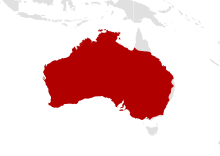| Singing honeyeater | |
|---|---|

| |
| Conservation status | |
 Least Concern (IUCN 3.1) | |
| Scientific classification | |
| Domain: | Eukaryota |
| Kingdom: | Animalia |
| Phylum: | Chordata |
| Class: | Aves |
| Order: | Passeriformes |
| Family: | Meliphagidae |
| Genus: | Gavicalis |
| Species: | G. virescens |
| Binomial name | |
| Gavicalis virescens (Vieillot, 1817) | |

| |
| Singing honeyeater's natural range | |
| Synonyms | |
|
Lichenostomus virescens | |
The singing honeyeater (Gavicalis virescens) is a small bird found in Australia, and is part of the honeyeater family Meliphagidae. The bird lives in a wide range of shrubland, woodland, and coastal habitat. It is relatively common and is widespread right across Australia west of the Great Dividing Range, through to the west coast and on Western Australian coastal islands. It does not occur in other countries.
Taxonomy
The singing honeyeater was originally described as Meliphaga virescens lipferti. It was previously placed in the genus Lichenostomus, but was moved to Gavicalis after a molecular phylogenetic analysis, published in 2011, showed that the original genus was polyphyletic. The generic name is formed from an anagram of the sister genus Caligavis; the specific epithet is the Latin virescens meaning 'greenish'.
Description
Singing honeyeaters can vary in length from 17–22 cm (6.7–8.7 in). Their overall appearance is grey-brown. The tail and wings are olive-green with flashes of yellow. There is a broad, black stripe running from the behind the beak to the back, and a yellow streak immediately below this from the eye. The bird's song ranges from scratchy to melodious. The song also varies according to where they live. The singing honeyeater has close relatives that have a similar general appearance, or some details in common, with overlapping ranges and similar voices, so a bird identification guide with clear visuals may be essential to attain the correct identity.
Ecology
Singing honeyeaters eat a variety of foods, including nectar, small insects, fruits, grubs, and berries. They are also opportunistic nest predators of smaller birds, including the zebra finch; any nest with eggs or chicks left unattended will be, potentially, an easy food source. This makes them omnivorous birds.
Singing honeyeaters breed between July and February. They are capable of forming longtime relationships with partners. When they are breeding, they show aggressive actions. Their nest is a cup of grass, plant stems, and spider webs. The eggs are a light cream-brown with some darker spots.
Singing honeyeaters live in families. They will attack larger animals, if they feel threatened by them, or if they enter their territory. They have been known to attack intruders in mobs, thus showing they are a community-minded bird that will work together for a common cause.
They associate with other species of birds, such as the brown honeyeater and the red wattlebird. They are different from many birds, however, because they lack the ability to communicate with isolated birds of the same species. As a study by M.C. Baker (1996) showed, the birds of the mainland did not respond to the songs of singing honeyeaters found on an island off Australia's west coast. The study showed that the songs of the birds on the island were shorter, had less song and syllable types, and had fewer syllables and notes per song.
Gallery
-
 Singing honeyeater, Rottnest Island, Western Australia
Singing honeyeater, Rottnest Island, Western Australia
-
 Singing honeyeater, Alice Springs Desert Park, Northern Territory
Singing honeyeater, Alice Springs Desert Park, Northern Territory
References
- BirdLife International (2016). "Gavicalis virescens". IUCN Red List of Threatened Species. 2016: e.T22704061A93950664. doi:10.2305/IUCN.UK.2016-3.RLTS.T22704061A93950664.en. Retrieved 19 November 2021.
- Morcombe, Michael (2000). Field Guide to Australian Birds. Box 1058, Archerfield, Qld: Steve Parish Publishing. p. 256. ISBN 174021417X.
{{cite book}}: CS1 maint: location (link) - "Meliphaga virescens lipferti". Western Australian Museum. Retrieved 2 May 2014.
- Nyári, Á.S.; Joseph, L. (2011). "Systematic dismantlement of Lichenostomus improves the basis for understanding relationships within the honeyeaters (Meliphagidae) and historical development of Australo–Papuan bird communities". Emu. 111 (3): 202–211. doi:10.1071/mu10047. S2CID 85333285.
- Gill, Frank; Donsker, David (eds.). "Honeyeaters". World Bird List Version 6.1. International Ornithologists' Union. Retrieved 28 January 2016.
- Jobling, James A. (2010). "Helm Dictionary of Scientific Bird-names". Retrieved 2020-04-25.
- Simpson, K.; Day, N. (2010). Field Guide to the Birds of Australia. Melbourne: Penguin Books. ISBN 9780670072316.
- Baker, M.C. (1996) "Depauperate meme pool of vocal signals in an island population of singing honeyeaters." Animal Behaviour 51:853-858
- "Birds in Backyards - Singing Honeyeater". Retrieved 2020-05-21.
- "Birds at the AALBG: Singing honeyeater". Friends of the Australian Arid Lands Botanic Garden. Retrieved 24 May 2018.
External links
- BirdLife Species Factsheet
- Photos, audio and video of singing honeyeater from Cornell Lab of Ornithology's Macaulay Library
- Recordings of singing honeyeater from Graeme Chapman's sound library
- Singing honeyeater. Birds of Perth
- "Singing honeyeater." birdphotos . 15 Dec 2006
| Taxon identifiers | |
|---|---|
| Gavicalis virescens |
|
| Melithreptus virescens | |